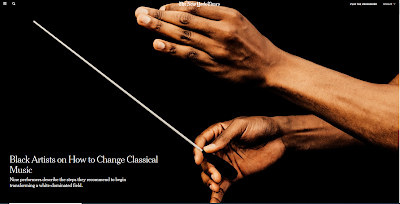
The conductor Roderick Cox.
Credit...Mustafah Abdulaziz for The New York Times
With their major
institutions founded on white European models and obstinately focused
on the distant past, classical music and opera have been even slower
than American society at large to confront racial inequity. Black
players make up less than 2 percent of the nation’s orchestras; the Metropolitan Opera still has yet to put on a work by a Black composer.
The
protests against police brutality and racial exclusion that have
engulfed the country since the end of May have encouraged individuals
and organizations toward new awareness of long-held biases, and provided
new motivation to change. Nine Black performers spoke with The New York
Times about steps that could be taken to begin transforming a
white-dominated field. These are edited excerpts from the conversations.
[Bassoonist] Monica Ellis in Harlem this month.Credit...Wayne Lawrence for The New York Times
The first step is admitting that these organizations are built on a
white framework built to benefit white people. Have you done the work to
create a structure that is actually benefiting Black and brown
communities? When that occurs, diversity is a natural byproduct. There
needs to be intentional hiring of qualified Black musicians who you know
are going to bring the goods to your audiences.

Thomas Wilkins conducting the Omaha Symphony, where he is music director, last year.Credit...Casey Wood
It’s incumbent upon leadership from the podium to be part of this: who
gets hired, what repertory gets played, where the orchestra plays. If
you’re not willing, for example, to have minority music interns playing
subscription concerts because they didn’t take the audition, that
doesn’t make any sense to me. This person needs the opportunity to play
this repertoire; you have to be willing to let that happen, and you
can’t bow to blowback from the full-time players.

Jessie Montgomery in Princeton, N.J., this month.Credit...Wayne Lawrence for The New York Times
I’m in my fifth year on the board of Chamber Music America, and more
than half the board is people of color. It’s very evenly balanced as far
as gender and race; those changes were implemented through consulting
work and training, and facilitated discussions among the board to make
sure everyone was on the same page.

[Conductor] Roderick Cox in Berlin this month.Credit...Mustafah Abdulaziz for The New York Times
I would like changes to be made in how we train musicians in
conservatories and universities. A lot of our thinking, and our
perceptions of what’s good music, becomes indoctrinated at that stage. I
say this because even though I’m a person of color, I was guilty of not
being accepting of new voices and styles outside of Beethoven,
Schumann, all the usual music of the past. When we start with
preconceived notions, we limit ourselves. People are afraid of being
uncomfortable, but with discomfort comes growth.

[Clarinetist] Anthony McGill in the Bronx this month.Credit...Miranda Barnes for The New York Times
Over the last month, you’ve seen all these outpourings, and it’s in
these moments when you see: Are we really connected with the communities
we’re doing this work in? At the New York Philharmonic, where I am
principal clarinet, I think there’s been incentive to partner up with
the Harmony Program, which does after-school music education.
[Singer] Lawrence Brownlee performing at the Church of the Intercession in Manhattan in 2018.Credit...Steven Pisano
Artistic institutions need to be focused on representing and really
serving the communities that they’re in. There needs to be community
engagement, not community outreach. Outreach is something you do
occasionally. But you’re always in the act of engaging; it’s a constant
effort.

[Composer] Terence Blanchard at a recording session for the Spike Lee film “Da 5 Bloods” last year.Credit...Matt Sayles/Netflix
It’s like anything else: The organizations need to represent what
America looks like. Well-intentioned people can just have blinders on. I
don’t look at it like a sinister plot; I look at it as people are going
with what they’re comfortable with. If we had more representation in
the leadership, in terms of who is signing off on projects, you’ll have
more people bringing things to the table. What I saw at Opera Theater of
St. Louis — where I did “Champion” and “Fire Shut Up in My Bones,”
which is going to the Met — is those people are open to a lot of ideas.
[Singer] Latonia Moore in Miami this month.Credit...Jeffery Salter for The New York Times
Please, in the future, cast with your heart, not just with your eyes and
your ears. Who gives you the goose bumps? Pick them. Some people see a
Black tenor, and they think Otello. Or they see a Black soprano and they
think Aida. “Who wants to see a Black Cio-Cio San?” You’ll hear that.
But yes, opera is a suspension of disbelief.
[Composer] Tania León in Nyack, N.Y., this month.Credit...Miranda Barnes for The New York Times
Certain groups of people have felt that they did not belong, because
most of the time they didn’t see people who resembled them onstage. But
even if things look good onstage, internally is that what is happening
in the institution? It’s a family type of thing. That person working in
the office goes home and tells the people at home, and they usually have
other friends. That is how audiences change. It has to be from the
inside out.














No comments:
Post a Comment